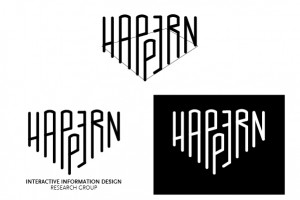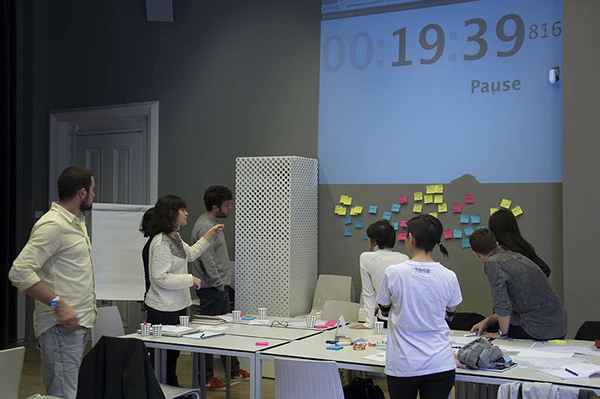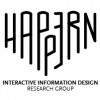Happern is a group of researchers interested in exploring interaction design ideas. The research group is a part of the Design Lab, in KUAR-Researcher Center for Creative Industries, located in Koç University. We specifically focus on interaction design research oriented into the problem space of complexity.
In 2013, we started with the name “IIDRG – Interactive Information Design Research Group”. However this was too long. Trying to seek a short name for our group, we brainstormed long-long times, did some surveys with friends on the name alternatives. First of all, we want to thank all our friends joining and sharing their ideas during the naming process. Finally, avoiding the results of the survey, we decided to use Happern which we think will create an emotional link with our motivations in the future.
* The word “Happern” doesn’t mean anything at all. We created the word from the words “pattern” and “happen”. The reason for coming up with such a word was to create a link between our search for patterns in interaction design and visualization + the motivation for exploring what is happening in the surrounding space around us.
Keywords: design, interaction design, information design, interface design, user experience design, visualization, complexity, disabling environment, mental model, autism, spatio temporal information, maps, information architecture.

How do we work?
Happern works in an interdisciplinary manner inline with the Design Lab and KUAR visions as well as the general perspective in the design research studies. We collaborate with people from many different disciplines such as psychology, sociology, history, computer science, political science and others.
We sometimes derive from the results of research in these fields, and sometimes collaborate during the holistic design process from the ideas we create. Cognitive psychologist help us learn about and analyze the mental models, and conduct user research in all stages; with sociologists we look for patterns in the society and run ethnographic methods to learn about groups of people; and together with the computer scientists or electronic or mechanic engineers we do reality check of what we dream of, or build prototypes of our ideas.
And these are the expected outputs of our studies: 1. Sign insights, patterns, guidelines 2. Publications to share these findings 3. Providing possible new ideas for other disciplines (Psyc., Sosc, CS) 4. Products and services for use in daily life for more effective interaction with complex situations.
So in general, starting with either a dream we have, a gap we spot, a pattern we realize, or with a gap shown to us by someone from another discipline, we elaborate on this start by:
(1) learning about the user or the group of users, employing user research methods coming from psychology, HCI or sociology (surveys, interviews, observations, card sorting, journal/diary studies, video ethnography…);
(2) then we ideate with the findings. In most of our projects we prefer to use participatory design methods such as workshops, roleplaying studies, games to design the information architecture, navigation structure, multimodal (visual, auditory…) language, interface or form design and interaction design;
(3) while learning about the user, the requirements and the design space, and designing or ideating, we start building prototypes (sketches, storyboards, video-sketches, paper/conceptual/working prototypes) from the first day to be able to conduct user studies (cognitive walkthrough, thinking aloud, heuristic evaluation, logging actual use…).
What do we do?
We intensively explore the world around us, spot complexities, research and dream possible solutions for simplifying these complex situations we all face during the daily life.
To elaborate on how we do it; we focus on the complex, unexpected, uncommon interaction and communication experiences happening between human and information, human and human via technology, or human and system. We spot these situations and analyze, ideate, dream, alter and design about them while looking for authentic interaction patterns. Our research outcomes might be a concept, prototype, product / application / service and most probably a scientific publication.

Theme 1: Designing the Information
We, Interactive Information Design Research Group, research and develop creative yet effective solutions for visualizing complex information in interactive environments, effective ways of interacting with it, and interface design. The first interest of our group pertains to visualization and interaction with the complex information. We work on crowded, complex, and obscure information which is encountered when accessed to the digital technologies to make it comprehensible for this concern.
For example, location-based data is generated continuously by the use of interactive technologies nowadays. The studies on interaction design and data visualization methods for location-based data to make it convenient and useful for daily life are cases from this scope. While exploring novel ways of visualization and interaction methods, we focus on maps. Maps are actually a solution to transfer our daily experiences to instantaneously others, or as information for future use. Maps can also be used for interpreting various needs of different people through the collected data from those people.
Theme 2: Designing the Experience
We examine complex, unexpected situations where humans encounter cognitive and environmental loads resulting in distraction, weak communication and inefficient interaction with the surroundings and technology. In this regard, we design attentive and adaptive spaces, artifacts and interfaces that refine different kind of environmental stimulus in order to assist humans in challenging situations.
Colors, patterns, shapes, sounds, movements, proxemics. These are the environmental stimuli we refine based on individual preferences in different environmental conditions and situations. Through ethnographical studies, we inform our design process considering these stimuli and their possible effects on the user as well as their interactions with surroundings.
Theme 3: Designing the Interface
Interfaces are a way to communicate with machines, and as the technology develops, both machines and their use become more complex. To reduce this complexity, make the machines more user-friendly and enhance human-computer interaction, we explore novel ways for interface design.
For a novel approach, we examine spatial augmented reality (SAR) to design interfaces. SAR projects virtual information onto user’s real environment by eliminating the need for an external device.
